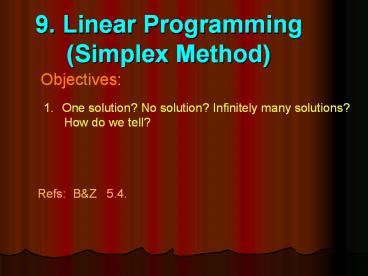9. Linear Programming (Simplex Method) - PowerPoint PPT Presentation
1 / 12
Title:
9. Linear Programming (Simplex Method)
Description:
9. Linear Programming (Simplex Method) Objectives: One solution? No solution? ... obtained incidentally. This tells us that there is more than one optimal solution. ... – PowerPoint PPT presentation
Number of Views:242
Avg rating:3.0/5.0
Title: 9. Linear Programming (Simplex Method)
1
9. Linear Programming(Simplex Method)
Objectives
- One solution? No solution? Infinitely many
solutions? - How do we tell?
Refs BZ 5.4.
2
Example
First we convert to standard form
3
(No Transcript)
4
No entry in the column is positive so there is
nowhere to pivot.
Our conclusion is that there is no optimal
solution. The feasible region is unbounded in
the direction of increasing P.
5
Another Example
First we convert to standard form
6
(No Transcript)
7
Look at the zeroes in the bottom row.
This tells us that there is more than one optimal
solution.
The solution we can read off is (x1, x2, s1,
s2)(0, 50, 0, 50) P 400
8
Lets go back to the equations and see what this
degeneracy means.
So P 400 provided s1 0.
Row 1 1/2 x1 x2 1/4 s1 50 Row 2 11/2
x1 - 1/4 s1 s2 50
Now lets set s1 0.
9
Row 1 1/2 x1 x2 50 Row 2 11/2 x1 s2
50
We can solve these equations simultaneously.
So we have x2 - 1/11 s2 500/11
x1 2/11 s2 100/11
Set t s2
x1 1/11(100 - 2t)
x2 1/11(500 t).
10
Now remember that x1, x2 , s2 0. So for x2
0 we need x2 1/11(500 t) 0
- 500 t 0
- t -500
and for x1 0 we need x1 1/11(100 - 2t) 0
- 100 - 2t 0
- t 50
So the optimal solution is (x1, x2 , s1, s2)
(1/11(100 - 2t), 1/11(500 t), 0, t) where 0 t
50, P400.
These equations represent the straight line
segment joining 1/11(100,500) to (0, 50).
11
(No Transcript)
12
You should now be able to complete Example Sheet
3 from the Orange Book.































